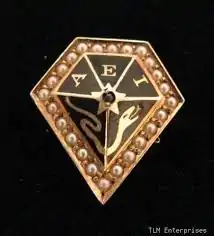Alpha Epsilon Iota
Alpha Epsilon Iota (ΑΕΙ) was a professional fraternity for women in the field of medicine.
| Alpha Epsilon Iota | |
|---|---|
| ΑΕΙ | |
 | |
| Founded | February 26, 1890 University of Michigan |
| Type | Professional |
| Emphasis | medical |
| Scope | national |
| Colors | Black , White and Green |
| Symbol | serpent |
| Flower | White Carnation |
| Jewel | emerald |
| Publication | The Directory-Journal |
| Chapters | 31, all dormant |
| Headquarters | USA |
History
Alpha Epsilon Iota was established as a medical fraternity for women on February 26, 1890 at the University of Michigan. It was thereby one of the earliest of the professional medical fraternities to serve women. It quickly expanded to a Beta chapter at the University of Chicago that same year, cementing its national intentions.[1][2]
By the turn of the century two additional chapters had formed, with seven more added by 1910. Later, growth slowed for the most part, with a flurry of new groups in the 1920, but no new chapters after 1949.[2]
The fraternity dissolved as a national organization in March, 1963. Some chapters continued on as local entities. Minnesota's Epsilon chapter remained active through the 1970s at which time there was a marked expansion of female enrollment in the growing medical school there, but ΑΕΙ sold its properties in 1979, splitting then into two groups, the AEI Foundation which continues to provide scholarships, and a networking organization called Minnesota Women Physicians.[3]
Traditions and insignia
The colors of Alpha Epsilon Iota were black, white and green.
The fraternity flower is the White Carnation.
The official badge is described as a "black enameled faceted pentagon, having a gold star at the apex with an emerald inset. The three upper facets contained the Greek letters Α Ε Ι in gold, the two lower facets, a gold serpent."
The biannual publication is The Directory Journal.
Six grades of members were created: Collegiate, Graduate, Honorary, Affiliate, Non-graduate, and Associate.[1]
Chapters
Chapter information from Baird's Manual (20th), which reports there were approximately 4,000 members.[1][2]
- 1890 – Alpha – University of Michigan
- 1890 – Beta – University of Chicago (dormant 1940)
- 1899 – Gamma – University of Cincinnati (dormant 1933)
- 1899 – Delta – University of Illinois at Chicago
- 1901 – Epsilon – University of Minnesota (dormant 1982)
- 1902 – Zeta – Stanford University
- 1902 – Eta – Cornell University (dormant 1913)
- 1902 – Theta – Woman's Medical College of Pennsylvania
- 1905 – Iota – University of California, San Francisco
- 1906 – Kappa – University of California, Los Angeles
- 1909 – Lambda – Syracuse University
- 1919 – Mu – Tulane University
- 1921 – Nu – University of Oklahoma
- 1922 – Xi – University of Oregon, Portland
- 1922 – Omicron – University of Kansas (dormant 1948)
- 1923 – Pi – Medical College of Virginia
- 1923 – Rho – University of Texas at Austin
- 1923 – Sigma – Ohio State University
- 1927 – Tau – University of Wisconsin–Madison
- 1927 – Upsilon – Southwestern Medical, Dallas
- 1927 – Phi – George Washington University
- 1927 – Chi – Washington University in St. Louis
- 1938 – Psi – LSU Health Sciences Center New Orleans
- 1940 – Omega – University of Tennessee
- 1941 – Alpha-Alpha – Marquette University
- 1944 – Alpha-Beta – Hahnemann University (Drexel)
- 1948 – Alpha-Gamma – Baylor College of Medicine, Houston
- 1948 – Alpha-Delta – New York Medical
- 1948 – Alpha-Epsilon- Temple University
- 1949 – Alpha-Zeta – Creighton University
- 1949 – Alpha-Eta- Augusta University
References
- Anson, Jack L.; Marchenasi, Robert F., eds. (1991) [1879]. Baird's Manual of American Fraternities (20th ed.). Indianapolis, IN: Baird's Manual Foundation, Inc. p. VIII-37. ISBN 978-0963715906.
- Early chapters noted in the "1922 Alpha Epsilon Iota Directory". Archived from the original on 2020-08-05., from the collection of the Medical College of Pennsylvania, accessed 10 Sept 2020.
- As noted in the University of Minnesota Academic Health Center Archives, accessed 10 Sept 2020.